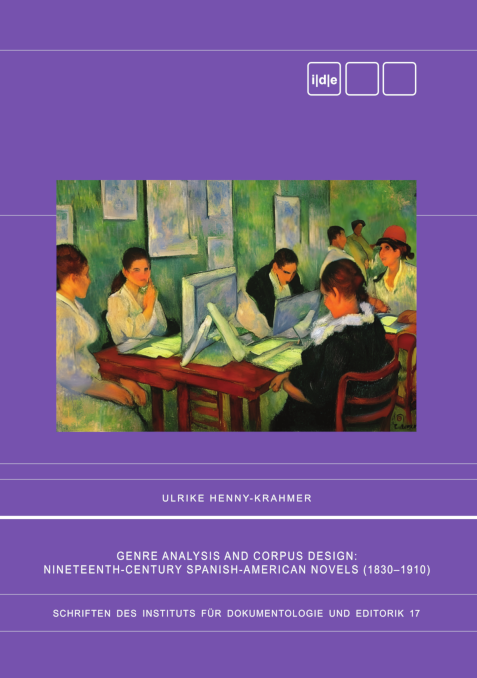Ulrike Henny-Krahmer: Genre Analysis and Corpus Design: Nineteenth-Century Spanish-American Novels (1830–1910). Schriften des Instituts für Dokumentologie und Editorik 17. Norderstedt: Books on Demand 2023.
Order and Access:
- Books on Demand: ISBN 978-3-7583-2030-9. 580 pages. 49,00 €. Available at https://buchshop.bod.de/genre-analysis-and-corpus-design-ulrike-henny-krahmer-9783758320309.
- Open Access version (PDF) at https://kups.ub.uni-koeln.de/71915/.
- Open Access version (HTML) at https://side17.i-d-e.de/.
Summary
This work in the field of digital stylistics and computational literary studies is concerned with theoretical aspects of literary genre, with the design of a corpus of nineteenth-century Spanish-American novels, and with its empirical analysis in terms of subgenres of the novel. The digital text corpus consists of 256 Argentine, Cuban, and Mexican novels from the period between 1830 and 1910. It has been created with the goal to analyze thematic subgenres and literary currents that were represented in numerous novels in the nineteenth century by means of computational text categorization methods. The texts have been gathered from different sources, encoded in the standard of the Text Encoding Initiative (TEI), and enriched with detailed bibliographic and subgenre-related metadata, as well as with structural information.
To categorize the texts, statistical classification and a family resemblance analysis relying on network analysis are used with the aim to examine how the subgenres,
which are understood as communicative, conventional phenomena, can be captured on the stylistic, textual level of the novels that participate in them. The result is that both thematic subgenres and literary currents are textually coherent to degrees of 70–90 %, depending on the individual subgenre constellation, meaning that the communicatively established subgenre classifications can be accurately captured to this extent in terms of textually defined classes.
Besides the empirical focus, the dissertation also aims to relate literary theoretical genre concepts to the ones used in digital genre stylistics and computational literary studies as subfields of digital humanities. It is argued that literary text types, conventional literary genres, and textual literary genres should be distinguished on a theoretical level to improve the conceptualization of genre for digital text analysis.
Resumen
Este trabajo en el campo de la estilística literaria digital y los estudios literarios computacionales se ocupa de las preocupaciones teóricas del género literario, del diseño de un corpus de novelas hispanoamericanas del siglo XIX y de su análisis empírico en términos de subgéneros de la novela. El corpus de textos digitales consta
de 256 novelas argentinas, cubanas y mexicanas del período comprendido entre 1830 y 1910. Ha sido creado con el objetivo de analizar los subgéneros temáticos y las corrientes literarias que estaban representadas en numerosas novelas del siglo XIX mediante métodos de categorización computacional de textos. Los textos han
sido recogidos de diferentes fuentes, codificados en el estándar de la Iniciativa de Codificación de Textos (TEI), y enriquecidos con detallados metadatos bibliográficos
y de subgéneros, así como con información estructural.
Para la categorización de los textos se utiliza una clasificación estadística y un análisis de semejanza familiar basado en el análisis de redes, con el fin de examinar cómo los subgéneros, entendidos como fenómenos comunicativos y convencionales, pueden ser captados en el plano estilístico y textual de las novelas que participan en ellos. El resultado es que tanto los subgéneros temáticos como las corrientes literarias son textualmente coherentes en grados del 70–90 %, dependiendo de la constelación individual de subgéneros, lo que significa que las clasificaciones de subgéneros establecidas comunicativamente pueden ser capturadas con precisición
hasta este punto en términos de clases textualmente definidas.
Además del enfoque empírico, la disertación también pretende relacionar los conceptos teóricos de género literario con los utilizados en la estilística de género digital y los estudios literarios computacionales como subcampos de las humanidades digitales. Se argumenta que los tipos de texto literario, los géneros literarios convencionales y los géneros literarios textuales deberían distinguirse a nivel teórico para mejorar la conceptualización del género para el análisis de textos digitales.
Zusammenfassung
Diese Arbeit ist in den Forschungsfeldern der digitalen literaturwissenschaftlichen Stilistik und der Computational Literary Studies angesiedelt und setzt sich mit theoretischen Gattungsproblemen, mit der Erstellung eines Korpus von hispanoamerikanischen Romanen des 19. Jahrhunderts und mit ihrer empirischen Analyse nach
Untergattungen auseinander. Das digitale Textkorpus umfasst 256 argentinische, kubanische und mexikanische Romane aus der Zeit von 1830 bis 1910 und ist mit dem
Ziel erstellt worden, thematische Untergattungen und literarische Strömungen, die im 19. Jahrhundert durch zahlreiche Romane repräsentiert waren, mit Hilfe computer-
gestützter Methoden der Textkategorisierung zu analysieren. Die Texte wurden aus verschiedenen Quellen zusammengetragen und gemäß dem Standard der Text Encoding Initiative (TEI) codiert, wobei die Dokumente mit detaillierten bibliographischen und untergattungsbezogenen Metadaten sowie mit textstrukturellen Informationen
angereichert wurden.
Um die Texte zu kategorisieren werden Verfahren der statistischen Klassifikation und eine Familienähnlichkeitsanalyse verwendet, die auf einer Netzwerkanalyse
basiert. Das Ziel der Analysen ist es zu untersuchen inwieweit die Untergattungen, die primär als Phänomene der Kommunikation und Konvention verstanden werden,
auf der stilistischen, textlichen Ebene der Romane, die an ihnen teilhaben, erfasst werden können. Das Ergebnis ist, dass sowohl die thematischen Untergattungen als
auch die literarischen Strömungen zu 70–90 % textlich kohärent sind, in Abhängigkeit der gewählten Untergattungskonstellation, womit gemeint ist, dass die kommunikativ
etablierten Untergattungsklassifikationen in diesem Maß an Genauigkeit auch als textlich definierte Klassen erfasst werden können.
Über die empirische Ausrichtung hinaus ist ein weiteres Ziel der Dissertation, literaturtheoretische Gattungskonzepte zu denjenigen in Beziehung zu setzen, die
in der digitalen Gattungsstilistik als einer Teildisziplin der Digital Humanities verwendet werden. Es wird argumentiert, dass literarische Texttypen, konventionelle literarische Gattungen und textliche literarische Gattungen auf einer theoretischen Ebene unterschieden werden sollten, um die Konzeption von Gattung für die digitale
Textanalyse zu verbessern.
